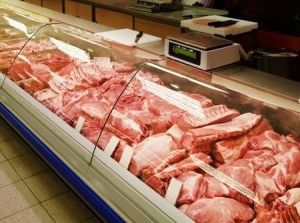
Everett Griner talks about our purchasing power and the actual cost of food in today’s Agri View.
Cost of Food
No, it’s not your imagination — food prices are sky high
by Mackensy Lunsford
If you find yourself suffering from sticker shock in the grocery aisle, it’s not your imagination. A confluence of factors, environmental and otherwise, is driving up prices for consumers.
Drought in California, where virtually all U.S. almonds and the majority of broccoli, garlic and spinach is grown, is tinkering with produce prices. Egg prices are climbing. Not even orange juice is safe, with a citrus greening disease causing bitter fruit and low production.
Even coffee is stressed, according to Waking Life Espresso cafe owner Jared Rutledge, who said a devastating fungus called coffee leaf rust is causing bean prices to rise.
Clearly the breakfast table is suffering, though not on the bacon front; pork prices are falling, one of the few sectors where there’s good news.
“There have been different things in different industries, but I think when you put it all together, it means overall, what people are spending on groceries has increased,” said Leah McGrath, Ingles dietitian.
 Eggs in particular have lately been bedeviling consumers. Avian flu has decimated almost 10 percent of the country’s population of laying hens, with wholesale prices reaching record levels on the national market, according to local egg farmer Mike Brown of Farside Farms.
Eggs in particular have lately been bedeviling consumers. Avian flu has decimated almost 10 percent of the country’s population of laying hens, with wholesale prices reaching record levels on the national market, according to local egg farmer Mike Brown of Farside Farms.
“About six weeks ago, eggs started going up five to six cents an egg a day, going as far as $2.50 a dozen wholesale — the highest it’s ever been,” Brown said.
Avian influenza, also known as the bird flu, is a virus that infects wild birds and domestic poultry, including chickens and turkeys. The most devastating form of the flu, HPAI, is a merciless and swift bird killer.
“When you have one sick chicken, you’re out of business,” Brown said. “You lose them all.”
So far, the flu has resulted in the deaths of nearly 50 million birds, largely in the Northwest and Midwest.
North Carolina is taking preventative measures to keep the disease from infiltrating the state, canceling poultry shows and disallowing fowl at state fairs after Aug. 1.
Even though the spread of the flu is slowing, eggs are still pricy as farmers try to recover. And even if prices return to normal this summer, there could be another epidemic as soon as cooler weather spurs migratory movements of wild birds, spreading disease again.
For now, poultry farmers are in rebuilding mode, Brown said. “It will take six months minimum to get those facilities back into production,” he said.
 It’s not just eggs that have consumers dropping extra cash at the store. Wholesale and retail beef is also at record highs.
It’s not just eggs that have consumers dropping extra cash at the store. Wholesale and retail beef is also at record highs.
“The beef cattle markets have soared due to a shortage of cattle,” Brown said. “They’re a long process; you can’t build them back overnight.”
Cattle inventory is down because the expense of raising, slaughtering and selling steers for meat at market is high, while the return is basically equivalent to what a farmer might fetch selling cattle in the stockyard.
“It’s a no-brainer,” Brown said. “You can just collect your check and go about your business.”
Eating their egg prices
Retail food operations rarely have the same options as wholesalers. At least two local bakers say they’re eating the rising cost of one of their most important commodities.
Karen Donatelli of Karen Donatelli Cake Designs is accustomed to fluctuations in cost, she said.
“We had heavy cream not long ago, and about four or five months ago, the butter prices were going through the roof,” she said.
But changing menu prices to reflect a volatile market is simply not feasible. Donatelli raised her prices shortly after the holidays, and doesn’t plan to do it again any time soon.
“I feel like we’re going to try to weather the storm,” she said. “Sometimes prices do come back down, and we’ll be right at where we’re supposed to be.”
At True Confections in the Grove Arcade, Carole Miller has seen prices for eggs soar more than 50 percent, climbing from $24 to $37 a case in one week.
But she’s not raising her prices either, she said. “It shouldn’t take that long for the next crop of layers to mature, but that was a big bite out of my food budget.”
Why are customers more willing to weather rising prices at the grocery store, but less tolerant of climbing restaurant prices? That’s just the way it is, Miller said. “Life’s not fair.”
John Brinker, scanning coordinator for the French Broad Food Co-Op in downtown Asheville, is one of the few grocers who could say his store would not see fluctuating egg prices.
“We tend to eat a little profit on eggs because you really want to give your customer a good, low price on eggs,” he said. “We may not be raising our price as much on those as our competitors might be.”
But the co-op’s egg prices haven’t changed much, he said, largely because they’re coming from local sources.
Brinker couldn’t say the same for almonds and almond products. “Almond milk, bulk almonds, almond crackers … are going up in direct proportion to the direness of the news from California about the water shortage,” he said. “My assumption has been that there’s a direct correlation there.”
Going nuts over prices
At True Confections, Miller said she’d be phasing out the use of almond milk soon, replacing it with soy products.
“It’s a more sustainable crop,” she said.
California, stricken by years long drought, produces more than 80 percent of the world’s almonds, and the trees’ water usage is substantial.
 The New York Times recently estimated that it takes 15.3 gallons to produce 16 almonds. Limits on water for California farmers means more stress for almonds, which translates to lower production and, eventually, higher prices.
The New York Times recently estimated that it takes 15.3 gallons to produce 16 almonds. Limits on water for California farmers means more stress for almonds, which translates to lower production and, eventually, higher prices.
McGrath said Ingles is working to keep the prices down on all produce, which may mean sourcing from other growing areas such as Texas and Mexico.
“But there’s so many things going on,” she said. “There’s a greening problem in Florida that’s devastating the orange crops.”
Last year, Florida produced just half of the oranges it had a decade earlier. According to information on the website of Uncle Matt’s Organic orange juice, once a tree is infected, there is no cure. It’s already devastated millions of acres of citrus crops throughout the United States and abroad.
The rapid decline of tree health has severely affected the $11 billion combined citrus industry in Florida and California, putting many growers out of business.
Currently, the rise of citrus greening has significantly reduced supply and driven up production costs, and growers and shoppers alike are feeling the pinch.
“There’s these problems in a lot of crops right now that have food suppliers wondering what’s next,” McGrath said. “If we have a drought problem in California and a greening problem in Florida, where are we going to get our citrus crop?”
 For now, McGrath said to work on curbing food waste and shopping smarter to help keep grocery bills down.
For now, McGrath said to work on curbing food waste and shopping smarter to help keep grocery bills down.
“We spend so little on food in comparison to other developed nations, but I think it’s so noticeable because people are on a more fixed income,” she said. “But we can be a nation that really wants the smorgasbord. We want all you can eat at one cost.”
At least for now, going shopping might require biting the bullet. With wages flat and the cost of goods rising, sometimes that’s easier said than done.
A look at 2015 food prices from the USDA
• Wholesale beef prices rose, increasing 0.8 percent on the month and are now up 12.3 percent year over year.
• Prices for farm-level eggs increased 35.4 percent from April to May; prices are now up 9.2 percent from May 2014 levels.
• The ongoing drought in California has raised concerns about rising produce prices at supermarkets or grocery stores. Prices for both farm-level fruit and vegetables rose in May. Farm-level fruit prices increased 3.9 percent in May, while farm-level vegetable prices rose 5.7 percent month over month — an indication that retail produce prices could further increase in the coming months.
Mackensy Lunsford covers food, restaurants and agriculture for the Asheville Citizen-Times. Lunsford has lived in the Asheville area since the ’90s, and spent many years cooking professionally before entering the field of food writing in 2005. Since then, Lunsford’s work has won several Alt-Weekly and North Carolina Press Association awards. Lunsford, a member of the Association of Food Journalists, joined the Asheville Citizen-Times in 2012 to help develop the paper’s food and restaurant coverage.









